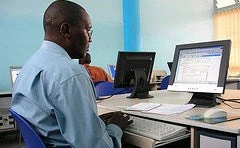
Jobs are at the very heart of living. Families escape poverty when their members secure gainful employment, and societies flourish when labor markets offer a wide range of job opportunities to citizens. And there is more to jobs than just monetary benefits. Not having a job or working under unfavorable conditions is often associated with low individual life satisfaction. Youth unemployment, in particular, can undermine the foundations of social cohesion, especially in fragile countries with a legacy of civil unrest and conflict.
As with most of sub-Saharan Africa, Tanzania has high male and female labor force participation.
- For instance, 97 percent of men and 92 percent of women aged 25 to 59 years are economically active. Tanzania thus ranks as one of the countries with the highest female labor force participation worldwide.
- Open unemployment is low, at just one percent of the labor force.
These aggregate employment statistics mean that almost all Tanzania adults do work, while in developed countries only 82 percent of adults are economically active. In Tanzania, like in other poor countries, most people cannot afford not to work. There is no unemployment insurance and other sources of income are minimal. As a result, most Tanzanians do any job even if it does not pay enough to make ends meet. The following statistics emphasize that many workers are only employed part-time or are confined in non-wage informal activities, and there are still large disparities between men and women:
- Underemployment is pervasive in rural areas as people spend on average only 27 hours per week on farm work which is the main activity for 80 percent of them.
- People with tertiary education are twice and seven times more likely to receive a salary than those with secondary education and primary education respectively.
- Men are more than twice as likely to be wage workers as women, while women are almost twice as likely to be hired as unpaid family workers.
- There are also wide earnings disparities – with a median wage of Sh30,000 per week, men earn twice as much as women (Sh15,000 per week).
The youth seem to be hardest hit by the lack of employment especially in urban areas. In Dar-es-Salaam, 57,000 youth between 15 and 24 years are unemployed, corresponding to an unemployment rate of 16 percent. Across the country, 183,000 youth are without a job.
Of course, the reality is more complex than suggested by these simple statistics. The rural population is migrating to benefit from the emerging labor market opportunities in cities and towns. Women may prefer self-employment to wage work because it gives them flexibility to combine economic activity with caring for children. And there is nothing wrong with the notion that education determines access to well-paying jobs, as long as the education system itself is merit-based and inclusive.
Yet, the evidence above suggests that labor market opportunities for many Tanzanians are limited, and so are their chances to lift themselves out of poverty and to increase their living conditions.
- Is it true that most Tanzanians are underemployed especially in rural areas?
- What skills and qualifications do Tanzanians need to access non-agricultural jobs? Is the education system geared up for this challenge?
- Should government directly hire or provide incentive to firms to promote the employment of youth?
- Should government support the private sector to create more jobs? How so?
- Are women discriminated in the labor market or are they making voluntary choices? What is the impact of traditional gender roles regarding care-giving and domestic chores?
- Should Tanzania build its development strategy around economic growth or around employment creation?
Note: The statistics above are based on the 2010/11 National Panel Survey and the ILO's Economically Active Population, Estimates and Projections database. All sources are publicly available.




Join the Conversation